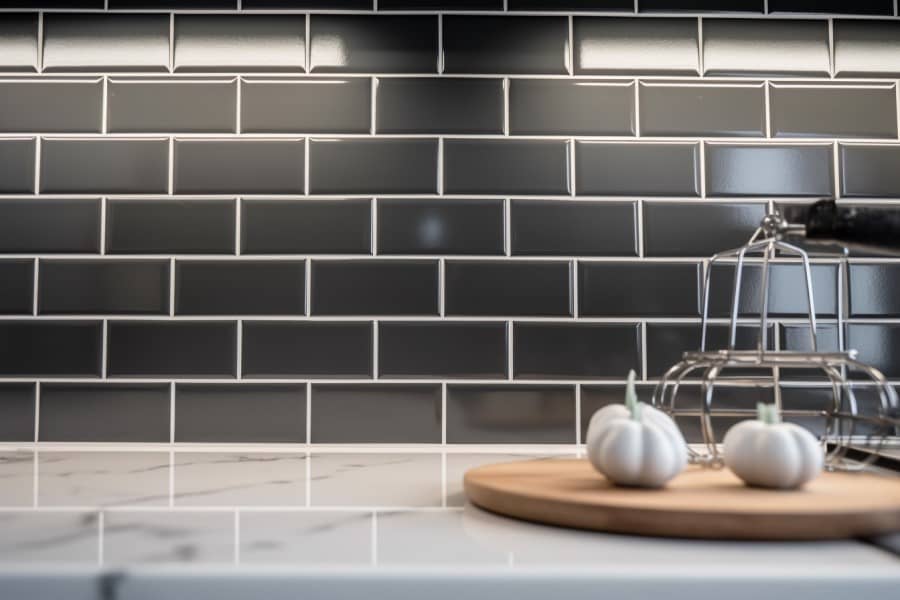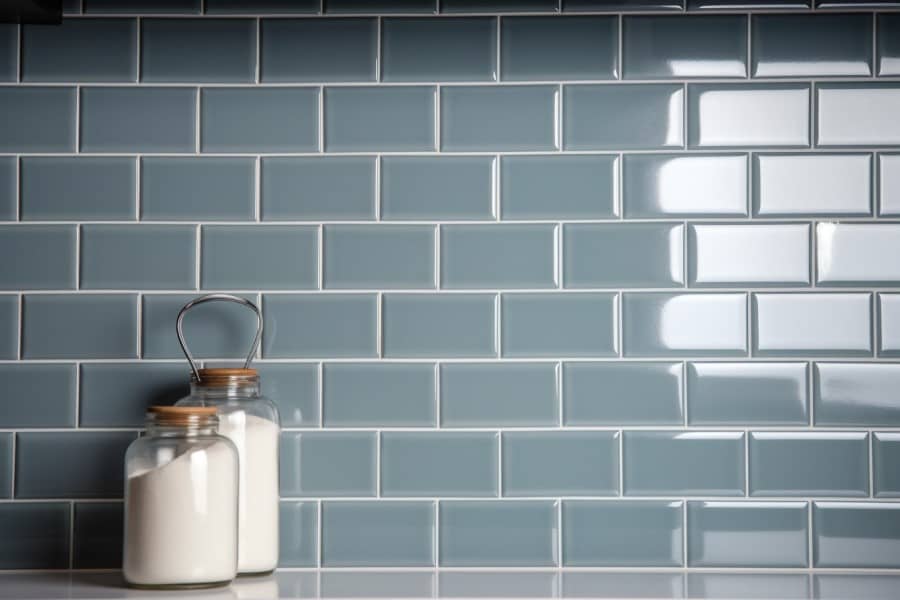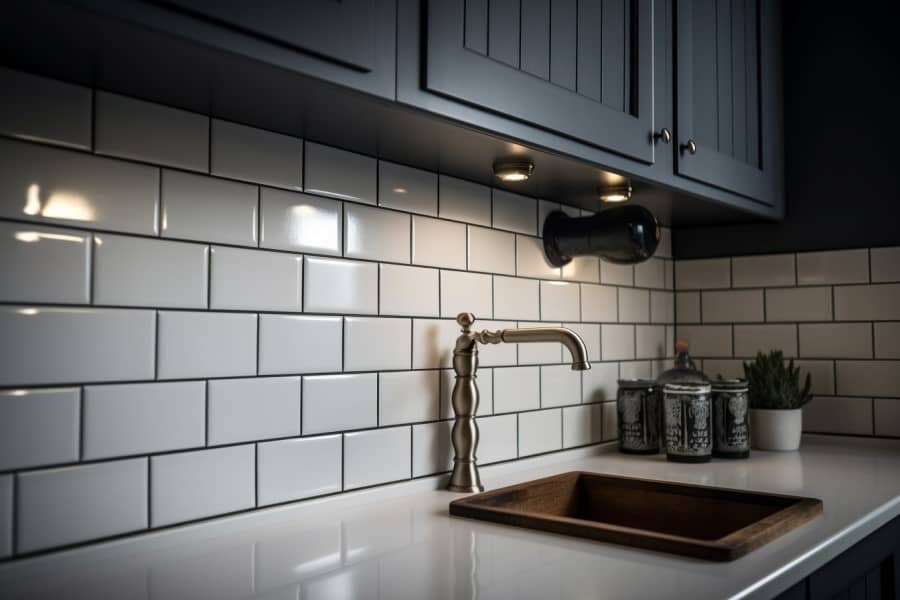Choosing the right grout color for your bathroom tiles can be a challenging task. I’ve spent a lot of time considering this on various projects, and you want to make sure that you pick something that will bring out the best in your tile and create an aesthetically pleasing space. After all, this is a huge part of the final look in your bathroom design!
I find this one of the more exciting parts of a bathroom reno or new build, so we’ll discuss some of my tips for choosing the perfect grout color for your bathroom so that you can create a stylish, inviting atmosphere.
With all these factors to consider when selecting grout colors, how do you know which option is best suited for your project? Read on as we explore different ways to choose the ideal grout color for your tiles!
Consider the Tile Material and Color
First off, you need to start with your chosen tiles and go from there. You can’t be throwing out random color choices for grout, without having a final decision made on your tile itself! I like to usually narrrow-down my choices of tiles to 1-3 options, and they are typically closely related. When I’m choosing tile, I know within a close proximity of what the overall design should be, so it makes life easier to nail down a final decision.
Once I have these 1-3 options for tile, I usually take samples to the space, and make my final choice then. A lot of times, you’re trying to make a decision in a store, and maybe its best to see the tiles in the actual space itself. Lighting within the space is a LOT different than stores, so keep that in mind.

Dark grey with clean bright white grout. Very modern and sleek look.
Contrasting shades can be used with lighter colored tiles to create interesting visual accents. For instance, if you have white or very light-colored bathroom tiles, you could use black or dark grey grout as an effective contrast. Contrasting grout gives an effect that will depend on the size of the tiled area; large expanses would look more striking with this bold choice.
Alternatively, if your bathroom has darker-colored tiles then using a pale gray shade of grout can bring out subtle details in the pattern of your selected tile design. This muted palette is ideal for making small rooms appear larger or brighter without overwhelming them visually.
By taking into account factors such as tile type and size, along with desired aesthetic effects like contrasting shades and light accents, you’ll should be able to pick the perfect grout color that complements your chosen bathroom tiles perfectly.
Choose a Grout Color that Compliments the Tile
Now, when choosing a grout color for your bathroom tiles, you want to make sure that it complements the tile itself. Matching shades are usually the safest choice as they will blend in with the overall look of your bathroom and won’t stand out too much. Sometimes that’s not what you’re going for, right?

Classic vintage blue glossy tile with a white grout. I like this one, and have very similar in my kitchen
Why Grout Color Matters
1. Perception of Space
- Light Grout Colors: Light grout colors tend to open up space and make a room feel larger and airier. Ideal for small bathrooms where you want to create an illusion of more space.
- Dark Grout Colors: Darker grout can add definition and depth, providing a bold, dramatic effect. This can be a striking choice in larger bathrooms or to highlight specific architectural features.
2. Cleanliness and Maintenance
- Light Grout Colors: While elegant, light-colored grout may show stains and discoloration more quickly, especially in high-traffic areas or where staining substances are used.
- Dark Grout Colors: Darker shades can be more forgiving of dirt and stains but may fade over time. Consider this when choosing grout for floors or busy shower areas.
3. Design Aesthetic and Style
- Monochromatic Approach: Using a grout color that matches the tile color creates a uniform and seamless appearance. It allows the pattern and texture of the tile to take center stage.
- Contrasting Approach: Contrasting grout colors create more defined lines and patterns, adding interest and a contemporary feel. For example, dark grout with white subway tiles is a classic choice that adds character.
- Neutral Approach: If your tiles are multicolored or have a complex pattern, a neutral grout color like beige or grey can unify the design without competing with the tile’s colors.
4. Complementary to Tile Material
- Natural Stone: With natural stone, a grout that complements the natural variations in the stone often works best.
- Glass Tiles: The reflective quality of glass tiles can be complemented or contrasted with grout color. A matching color can give a sleek look, while a contrasting color adds vibrancy.
5. Practical Considerations
- Test Samples: Always test grout samples with your chosen tiles to see how they look together. Grout color can change slightly when it dries.
- Professional Consultation: If in doubt, consulting with a professional tile installer or designer can provide insights tailored to your specific situation and design goals.
If you’re feeling more daring you can use an accent color instead which will bring a bit of contrast to your bathroom design. This is a popular option, especially for small powder rooms lately. I’ve seen tons of awesome, high-contrast bathroom tile jobs lately (bright white and black grout/dark grout)where the grout vs the tile couldn’t be any more contrasty! And, I love it! Here’s a great table that may help:
| Tile Color | Complementary Grout Color | Notes |
| White | Light Grey | A light grey grout highlights the crispness of white tiles. |
| Cream | Ivory | An ivory grout enhances the warmth of cream-colored tiles. |
| Blue | White or Matching Blue | White grout offers contrast, while matching blue provides a seamless look. |
| Earth Tones | Sand | A sand-colored grout complements natural earth-toned stone tiles. |
| Multicolored | Neutral (Beige or Grey) | Neutral grout supports the varied colors without competing with them. |
| Classic White | Dark Grey | Dark grey grout emphasizes the classic pattern of subway tiles. |
| White with Veins | Matching White | A matching white grout accentuates the luxurious appearance of marble. |
| Dark Grey/Black | Charcoal | A charcoal grout highlights the rich, dark color of slate tiles. |
| Terracotta | Brown or Terracotta | A matching terracotta or brown grout complements the rustic charm of terracotta tiles. |
Whichever option you go for, make sure it looks good with other elements such as cabinets and countertops so everything coordinates well together.

Clean bright white subaway tiles with a very dark black grout. Striking and goes well with modern or transitional homes.
Consider getting samples from different stores or online retailers and test them against your tiles before making a final decision. You don’t want to end up spending all this money just to realize afterwards that the colors clash! It’s important not to rush into anything when selecting a grout color for your bathroom tiles.
Take the time to think about how it’ll fit into your overall plan and then decide what works best for you. After all, making these decisions now might save you some headaches later down the road!
Consider the Size of the Tiles
Now that you’ve got a good grasp on how color can affect the look of your bathroom tiles, it’s time to consider another important aspect: tile size. Choosing grout colors for larger or smaller tiled areas requires different approaches. Let’s cover what that means below.
When tiling large surfaces, like walls, try to match the texture and color of the grout with the surrounding room décor. The goal is to create an overall unified look in which individual tiles are not particularly noticeable, so choose a similar tone as much as possible. If you’re looking to make a statement and draw attention to your unique pattern, however, feel free to experiment with richly hued options or even contrasting shades.

Light marble with grey veining, complete with a light grey grout. Very appealing and goes perfectly with the marble countertops in this home.
For small-scale applications such as mosaic designs or backsplashes, matching tones may be less necessary since these areas typically require more detailed design elements anyway. Here you can get creative with bright colors – from navy blue to salmon pink – without worrying about overpowering other features in the room. Get wild and have fun creating something truly one-of-a-kind!
• Match textures & colors when tiling large surfaces for a unified look
• Experiment with richly hued options for making statements
• Try bolder shades for small scale applications such as mosaics and backsplashes
• Have fun getting creative with unique designs and adding personality to your space.
Select A Grout Color That Is Easy To Clean
Making sure the grout color you choose for your bathroom tiles will not only be aesthetically pleasing, but also easy to clean is an important part of any renovation.
When selecting a grout color, ensure compatibility with other colors and materials in the space; opt for durability when choosing from available shades and finishes.
For those looking to minimize their cleaning burden, there are certain colors that can help cut down on maintenance time.
Bright whites or light grays may look attractive at first glance, but they tend to show dirt easily and must be regularly cleaned.
Darker hues such as mid-tone blues or rich charcoals are often better choices since these colors don’t pick up dirt as easily.
Additionally, it is essential to select a quality grout sealant before installation begins.
Applying a high-quality product after curing helps protect against staining and makes future cleanup much easier – simply apply more coats every few years if needed!
No matter what color you decide on, investing in quality products now will save time and money later.
Use Grout Sealer for Added Protection
Once you’ve picked out the perfect grout color for your bathroom tiles, there is one more step to ensure their longevity: consider using a grout sealer.
What do I use?
Seal It Green grout sealer works really well, is easy to spray on, and seems to do a good job at sealing the grout, preventing stains. I love how it is ZERO VOC, which is super-important to look for in these types of products.
Check Price on AmazonGrout sealants are a type of protective coating that can be applied over the grout lines in between tiles and help prevent staining and water damage. These are particularly helpful in bathrooms, where in areas like the shower, are prone to discoloration and mildew buildup.
Using grout sealants also makes regular cleaning much easier since dirt and debris won’t penetrate deeply into the joints like it might without protection. This gives you help when it comes to cleaning; you can get away with less-frequent deep cleans in your bathroom. Win!
Wrap Up
Hopefully this has been helpful, and choosing your tile grout color is less of a headache. The decision of what color to use in your bathroom tiles can seem frustrating sometimes, but with a few considerations it doesn’t have to be.
When selecting the right grout color for your bathroom tiles, consider the material and color of the tile and select a grout color that is easy to clean and compliments the tile. Then consider using a grout sealer for added protection.
With these simple tips you’ll be able to choose the perfect grout color for your bathroom tiles! I’m sure you’ll love how great it looks once it’s completed.



